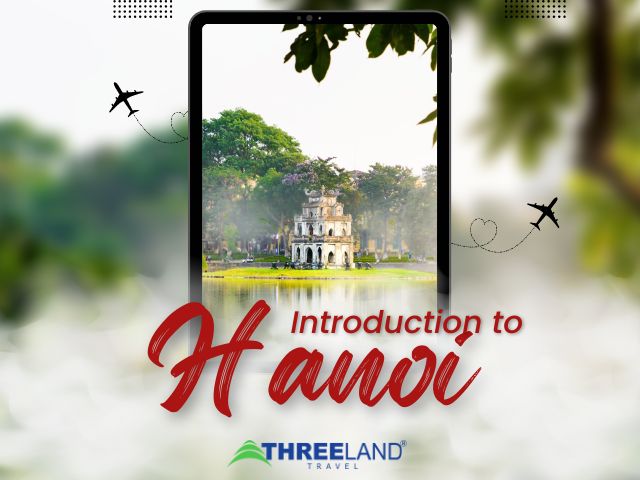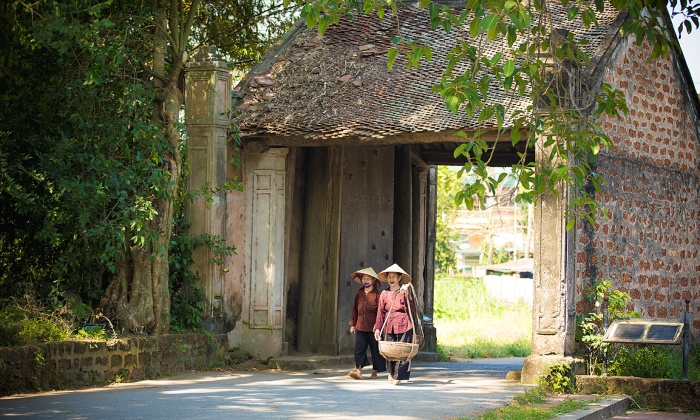Introduction to Hanoi is an interesting and fascinating topic for those who love traveling and discovering the local culture. Hanoi is not only the capital and center of politics, culture and education of Vietnam, but also a piece of land with a long
TABLE OF CONTENTS
1
1. Introduction to Hanoi Capital
1.1. Geographical location
1.2. Introduction to Hanoi – Climate
1.3. History of Hanoi thousand years of civilization
1.4. General introduction about Hanoi – Culture and people
2
2. Introduction to Hanoi's scenic spots not to be missed
2.1. Tourist attractions in the city center
2.2. Attractive tourist destinations in the suburbs
3
3. Introducing Hanoi products to enjoy and buy as gifts
Introduction to Hanoi is an interesting and fascinating topic for those who love traveling and discovering the local culture. Hanoi is not only the capital and center of politics, culture and education of Vietnam, but also a piece of land with a long history up to thousands of years old.
Traveling to Hanoi is an interesting and memorable experience if you take the time to read the introductory articles about Hanoi. Thereby, you will know more interesting activities such as: exploring the historical sites of the city; Check-in at many famous destinations or enjoy delicious and unique local dishes.

1. Introduction to Hanoi Capital
If you are coming to Hanoi for the first time, do not forget to refer to the introductory information about Hanoi Capital including: Geographical location, climate, history, culture and people to have the best trip preparation for Hanoi. .
1.1. Geographical location
Hanoi is the capital and one of two special urban areas of Vietnam. In the articles about Hanoi, this city is located from 20°53' to 21°23' North latitude and 105°44' to 106°02' East longitude, in the central area of the delta of the fertile Red River.
Hanoi borders the provinces of Thai Nguyen, Vinh Phuc, Ha Nam, Hoa Binh, Bac Giang, Bac Ninh, Hung Yen and Phu Tho. Besides a large natural area of about 3,358.6 km², Hanoi also has a rich and diverse river system such as the Red River, Duong River, Cau River, Day River and Nhue River.
If you dig deeper in the general introduction about Hanoi, you will know that the capital is also divided into 30 urban districts, including 12 inner city districts and 18 suburban districts. It can be said that the geographical position of Hanoi has important economic, transportation, military and political significance for the whole country.

1.2. Introduction to Hanoi – Climate
Hanoi is a typical region with a tropical monsoon climate and high humidity. Therefore, this is also the place where the four seasons of Spring, Summer, Autumn and Winter are most obvious in the year. To have a complete trip, don't forget to carefully read the weather and climate section in the introduction to Hanoi.
Summer in Hanoi is usually hot and rainy, lasting from May to September; winter is cold and dry, lasting from November to March next year. The two seasons with the most beautiful and pleasant weather in this city are spring and autumn because at this time the climate becomes quite pleasant and cool.

1.3. History of Hanoi thousand years of civilization
Many people in the capital are always proud to introduce Hanoi as a land of thousands of years of civilization, which is associated with heroic historical anecdotes of the Vietnamese nation. Possessing an important strategic position, this was also the capital of most of the ancient feudal dynasties such as the Dinh, Ly, Tran and Le dynasties.
According to historical documents of Hanoi, in 1010 King Ly Thai To chose Co Loa as the capital and named it Thang Long, which means Flying Dragon. Since then, Thang Long has become a symbol of the country's prosperity and rise. Over the past 1000 years, Thang Long has had many different names such as Dong Do, Dong Kinh, Bac Thanh... until 1831, it was renamed Hanoi.
Not only witnessed many important historical events of the nation such as the Lam Son uprising, the August Revolution and the National Day of September 2, 1945, the resistance war against the US... Hanoi is also home to many Famous historical sites such as Temple of Literature - Quoc Tu Giam, One Pillar Pagoda, Cathedral, Hoa Lo Prison, Uncle Ho's Mausoleum...
Besides, the capital also has famous streets that are often mentioned through the introduction of Hanoi's Old Quarter such as: Hang Ma Street, Hang Gai Street, Hang Dao Street... These folk names are named after the main product of the craft village and has become an integral part of the lives and activities of the local people here.

1.4. General introduction about Hanoi – Culture and people
Whenever hearing about Hanoi, anyone immediately remembers interesting things about the culture and people of the capital. Hanoi's culture is very diverse and rich, reflected in traditional arts, music, literature... Cultural heritages such as ca tru, xam singing, water puppetry and cheo singing still exist and are passed on many generations.
Hanoi is also home to many universities, research institutes, and cultural centers, attracting writers, artists, and cultural activists from all over the world. Cultural events, exhibitions, festivals… take place regularly, creating a vibrant and rich cultural exchange space.
Through the introduction of Hanoi city, many visitors are also more impressed with the people here. They have many good qualities such as: simplicity, justice, kindness, patriotism and high national pride. Hanoians are also famous for their spirit of preserving and promoting traditional cultural values, while absorbing and learning the cultural quintessence of humanity.
The above characteristics are often mentioned in many articles or videos about Hanoi. However, only by being directly exposed and admired can you understand and feel deeply about the cultural beauties and vibrancy of the Capital.

2. Introduction to Hanoi's scenic spots not to be missed
When you hear about Hanoi's scenic spots, you will know many famous places associated with the name of the land of thousand years of civilization. According to the introduction of Hanoi by local people, this place has many unique attractions both inside and outside the city.
2.1. Tourist attractions in the city center
No need to travel far to visit the most famous tourist attractions in Hanoi, you just need to walk around the inner city to discover countless interesting destinations such as:
- Hanoi Old Quarter: Through the story and introduction of Hanoi, the Old Quarter is definitely a place that you must visit once. In addition to the old-style houses, the old town also has famous check-in points in Hanoi such as Ngoc Son Pagoda, Cathedral, Thang Long Puppet Theater...
- Hoan Kiem Lake: A symbol of the country's prosperity and rise through many introductions about Hanoi. The origin of the lake is related to a famous historical story: King Le Loi returned the sword to the god Kim Quy after fighting the Ming invaders.
- Temple of Literature is a most important historical and cultural relic of the capital and the whole country, built in 1076 under the reign of King Ly Nhan Tong. The Temple of Literature is the place to worship Confucius and the sages of Confucianism and is also the first university of Vietnam.
- Ho Chi Minh Mausoleum is also a place often mentioned when introducing Hanoi, this is the resting place of the beloved leader Ho Chi Minh. The mausoleum is the place to show the gratitude and respect of the Vietnamese people to President Ho.
- Imperial Citadel of Thang Long: As a national historical and cultural relic, recognized by UNESCO as a World Cultural Heritage in 2010. The citadel has a large area, including many important architectural works, such as: North Gate, South Gate, Dai La Thanh, Kinh Thien Palace, Long An Palace…
- West Lake: Is a famous place in the introduction of Hanoi tourism by local people. West Lake has a spacious and airy lakeside with many trees and flowers, suitable for those who want to enjoy the fresh air and relax.

2.2. Attractive tourist destinations in the suburbs
What is there to play and visit in the suburbs of Hanoi? If you have heard many recommendations about Hanoi but still do not know where to go, the following tourist attractions near Hanoi will be great suggestions for you:
- Bat Trang Pottery Village: Is a long-standing traditional craft village in Gia Lam district - Hanoi, famous for its diverse and sophisticated ceramic products. Here, visitors can admire the process of making pottery, experience making pottery at will, and shop for souvenirs.
- Duong Lam ancient village has been around for more than 1200 years through the introduction of Hanoi by the people here. The village was also recognized as a national cultural heritage in 2006. It still preserves many ancient historical, cultural and architectural relics, such as ironwood stilts, communal houses, temples, etc.
- Ba Vi National Park: A garden with an area of more than 10,000 hectares, including the three highest mountains, Peak King (1296m), Tan Vien Peak (1276m) and Ngoc Hoa Peak (1131m). Ba Vi National Park is quite biodiverse with many rare species of flora and fauna.

Duong Lam ancient village
3. Introducing Hanoi products to enjoy and buy as gifts
In the information about Hanoi, this land is also famous for its unique local gifts. Those who go on business or travel to Hanoi want to buy some typical dishes here as gifts.
When you are introduced to Hanoi products, you will be overwhelmed by the diversity and richness of the capital's cuisine. Among them, the Hanoi specialties you should try include:
- Pho Hanoi: A dish made from thinly sliced pho noodles, cooked/re-cooked beef combined with a sweet and savory broth that is simmered from beef bones and spices such as cinnamon, anise, cloves... Food with flavor The characteristic richness and purity has made many visitors fascinated, remember and never forget.
- Vermicelli with shrimp paste is also an extremely famous street food in reviews or introductions about Hanoi. A serving of bean vermicelli includes fresh vermicelli, crispy golden fried tofu, minced fried rice and shrimp paste mixed with lemon and rich sugar. You can easily find this dish in many restaurants or street vendors.
- Bun thang: An elegant and nutritious dish, often eaten on holidays or when you want to change your taste. This specialty has a sweet broth, simmered from chicken and dried shrimp, served with shredded toppings such as chicken, omelette, pork rolls and chopped celery…
- Egg coffee is usually made from traditional filter coffee combined with beaten egg yolks with condensed milk and sugar. Egg coffee has a rich and sweet cream on the top and a rich black coffee layer on the bottom.
- Tay Ho lotus tea is also a special gift that is often mentioned in articles about Hanoi. This is a high-class and rare tea in Hanoi, made from dried green tea leaves soaked in lotus water to absorb the scent of lotus flowers. Tay Ho lotus tea has a mild and pure fragrance, bringing a feeling of purity and comfort to the drinker.
- Green sticky rice cake: Belonging to the top dishes that are often bought by tourists as gifts. Hanoi rice cake is light green in color, square in shape, sweet and fragrant. Banh Com is also an indispensable dish in Tet holidays, especially Mid-Autumn Festival and Lunar New Year.

With a long history of thousands of years of civilization and many heroic historical relics, unique cultural features, diverse local cuisine... Hanoi is considered the most attractive destination among the provinces and cities in Vietnam. Through the brief introduction about Hanoi above, Threeland Travel hope you have a better understanding of the beautiful capital land and love the culture and people here.
Read more:










